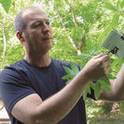Alliaria petiolata is a widespread biennial herb from Eurasia that is one of the most recognizable invasive plants of forests in the eastern United States and southern Canada. After two decades of intensive study on its physiology, ecology, and impacts, this plant has come to be known in both the scientific and gray literature as an allelopathic plant capable of exerting negative, chemically mediated effects on plants and microbes in its environment. A critical review of the literature reveals that there is evidence both supporting and failing to support this assertion, and that conclusions can be affected greatly by the experimental approaches taken, the target species examined, the sources of allelopathic inputs, and environmental factors. The objective of this review is to provide a history of allelopathy research in A. petiolata, describing the various approaches that have been taken and conclusions drawn, and to summarize the current standing of A. petiolata as an allelopathic plant using the most ecologically relevant data on this phenomenon. Finally, we discuss the degree to which allelopathy, versus other mechanisms, may contribute to the invasive success of this plant.
Available at: http://works.bepress.com/don-cipollini/5/
